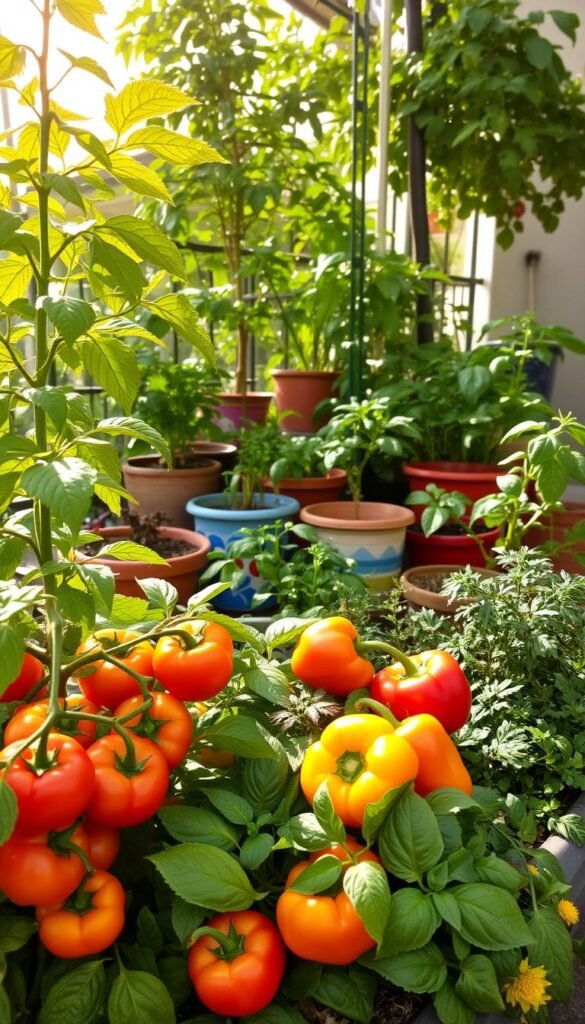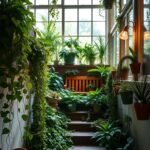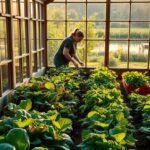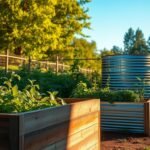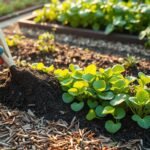Transforming your outdoor area into a vibrant food source is easier than you think. With smart container arrangements, even a modest patio becomes a productive space bursting with ripe produce and aromatic herbs. All it takes is sunlight, proper planning, and the right plant choices.
Most edible plants thrive with 6-8 hours of direct sunlight daily. This makes tomatoes, peppers, and eggplants ideal candidates for sunny spots. If your area gets 4-6 hours of light, try leafy greens or basil – they’ll flourish without full-day exposure. Strategic placement turns every corner into a potential growing zone.
Discover how to maximize vertical space and pair compatible crops in our guide to compact vegetables perfect for small spaces. You’ll learn why container cultivation gives precise control over soil quality and drainage – key factors for healthy roots and abundant harvests.
Whether you’re renting or simply short on yard space, this approach lets you enjoy homegrown meals without sacrificing style. Imagine plucking sun-warmed cherry tomatoes steps from your lounge chair or garnishing dinners with freshly clipped parsley. Your outdoor haven can be both beautiful and functional.
Getting Started With Your Potted Garden Adventure
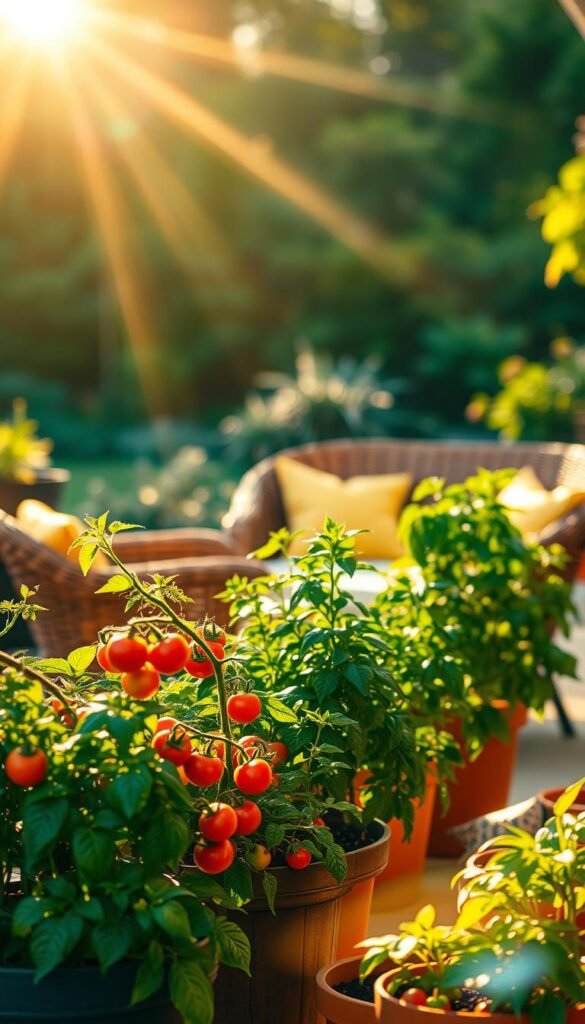
What if your morning coffee spot could double as a fresh salad bar? Successful edible spaces begin with smart observation. Start by tracking how light moves across your deck or balcony – this determines which plants will prosper where.
Assess Your Patio Space and Sunlight
Grab a notebook and record light patterns every 2 hours for three days. South-facing areas often get full sun, while east-facing spots receive gentle morning rays. Use this simple table to match plants with your findings:
| Light Needs | Daily Hours | Best Choices |
|---|---|---|
| High | 8+ | Fruiting plants |
| Medium | 6 | Root crops |
| Low | 4 | Leafy greens |
Keep containers at least 12″ from brick walls. These surfaces amplify heat, which can stress plants. One gardener noted:
“Moving my basil away from the stucco wall stopped leaf scorch completely.”
Planning Your Garden Layout
Arrange taller crops like pole beans north of shorter plants to prevent shading. Leave 18″ between large containers for air circulation. Consider these tips:
- Place wheeled planters near seating areas for flexible space use
- Group herbs needing similar water together
- Reserve prime sunny corners for heat-loving varieties
Your layout should balance easy access with visual flow. A well-planned garden becomes both productive and inviting – no yard required.
Choosing the Right Containers and Soil
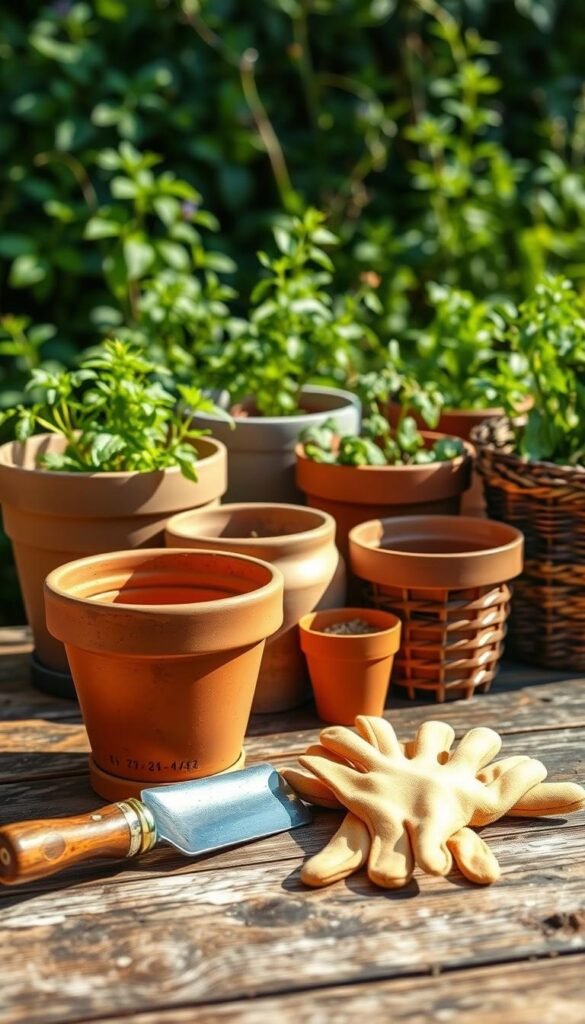
Your container garden’s success starts with two crucial decisions: what to plant in and what to plant with. Let’s dig into the essentials for creating thriving root environments.
Exploring Container Options and Drainage Essentials
Size matters more than you think. Vegetables need room to stretch their roots – tomatoes and peppers demand containers at least 18″ wide. Smaller pots dry out faster and limit growth.
Material choices impact plant health:
- Plastic pots retain moisture but may overheat
- Clay breathes well but dries quickly
- Wood offers insulation but requires lining
Drainage holes prevent soggy roots. For solid plastic containers, drill ¼-inch openings along the sides near the bottom. One gardener shared:
“Adding side holes changed everything – my basil stopped drowning during summer storms.”
Selecting the Best Potting Mix for Container Gardening
Skip regular garden soil. Synthetic mixes provide better airflow and moisture control. Look for these ingredients:
- Peat moss or coconut coir for water retention
- Perlite for drainage
- Compost for nutrients
Quality mixes feel light and fluffy, never compacted. For extra insurance against root rot, add a handful of coarse sand. When growing vegetables in containers, refresh the soil each season to maintain fertility.
Potted Vegetable Garden: Grow Tomatoes, Peppers, and More on Your Patio

Choosing the right plant varieties transforms limited spaces into productive edible displays. Modern breeders have developed space-smart cultivars that deliver full-sized flavors in compact packages. Look for seed packets labeled “patio,” “bush,” or “dwarf” – these terms signal container-ready genetics.
For juicy tomatoes without the jungle-like growth, select determinate types. These stop growing at 3-4 feet while producing heavy clusters. A satisfied gardener shared:
“My ‘Tiny Tim’ plants gave 50 cherry tomatoes each – perfect for my balcony rail planters.”
Peppers thrive in containers when you pick the right varieties. Compact options like ‘Patio Snacker’ yield full-sized fruits on 18-inch plants. Pair them with dwarf basil for a flavor-packed corner.
| Plant Type | Container Size | Yield Potential |
|---|---|---|
| Determinate Tomato | 5-7 gallons | 8-12 lbs |
| Dwarf Pepper | 3-5 gallons | 15-20 fruits |
| Bush Cucumber | 10-12″ wide | 10-15 cukes |
Leading seed companies like Burpee offer specialized lines for container gardening. Their compact vegetables maintain robust flavors while fitting smaller pots. Remember:
- Match plant height to container depth
- Group similar water needs together
- Prioritize disease-resistant varieties
With these tailored choices, you’ll enjoy abundant harvests from plants designed to excel in cozy quarters. Modern breeding proves big flavors don’t require sprawling gardens.
Selecting Compact and Dwarf Vegetable Varieties
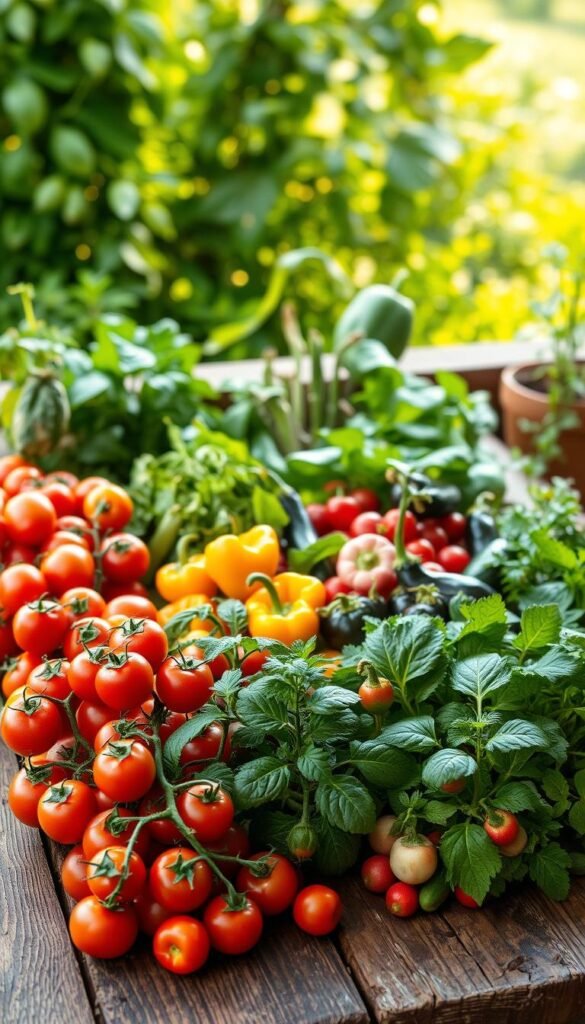
Compact varieties bring big harvests to small spaces. The secret lies in selecting plants bred specifically for container life. These space-savvy options deliver full-sized flavors without sprawling growth.
Top Performers for Tight Quarters
Tomatoes shine when you pick determinate types like ‘Patio Princess’. These stop growing at 3 feet but produce clusters of juicy fruits. One gardener reported:
“My ‘Tiny Tim’ plants yielded 45 snack-sized tomatoes from a 12-inch pot!”
Peppers thrive in containers too. Dwarf varieties like ‘Lunchbox’ offer sweet crunch, while ‘Patio Snacker’ packs heat. Pair them with basil ‘Spicy Globe’ – its 8-inch height fits anywhere.
Why Bush-Type Plants Excel
Compact plants save space and simplify care. Bush beans outproduce pole types in pots, while dwarf cucumbers climb modest trellises. See how top varieties compare:
| Plant | Container Size | Key Benefit |
|---|---|---|
| Bush Squash | 10 gallons | No vines |
| Dwarf Eggplant | 5 gallons | Early harvest |
| Mini Bell Pepper | 3 gallons | Colorful display |
Herbs like thyme and oregano flourish in shallow pots. Chives add vertical interest, while parsley makes lush edging. Combine 2-3 herbs in wide planters for instant kitchen gardens.
Leading seed companies like Burpee offer special container collections. These verified performers ensure success, even on fire escapes. Remember – matching plant size to pot depth prevents root crowding.
Establishing a Reliable Irrigation System
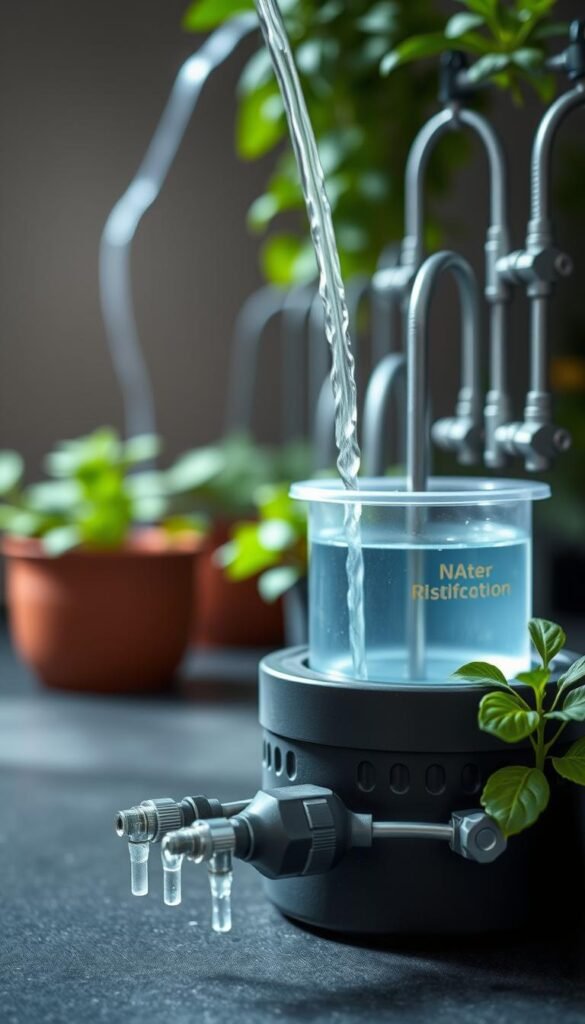
Did you know container soil dries 2-3 times faster than garden beds? Proper hydration keeps your edible oasis thriving without turning it into a swamp. Let’s explore smart solutions for maintaining perfect moisture levels.
Drip Irrigation and Consistent Watering Solutions
Small pots need attention multiple times daily in hot weather. A basic drip system solves this with minimal effort. Connect a timer to deliver water at dawn and dusk – peak absorption times.
| Method | Frequency | Best For |
|---|---|---|
| Hand Watering | 1-3x/day | Small collections |
| Drip Lines | Auto-scheduled | Busy gardeners |
| Self-Watering Pots | Weekly refills | Vacation periods |
Check soil moisture by pushing a finger 2″ deep. If it feels dry, water thoroughly until liquid escapes drainage holes. One urban gardener noted:
“My ollas (clay watering vessels) cut watering chores by 70% while keeping herbs perfectly hydrated.”
Wind and container material dramatically affect drying speed. Glazed pots retain moisture longer than terracotta, while metal heats up faster. Pair drought-tolerant varieties with breathable fabric planters for low-maintenance success.
Watch for these warning signs:
- Crispy leaves = Underwatered
- Yellowing foliage = Overwatered
Automated systems prevent guesswork while conserving resources. Your plants get exactly what they need, when they need it – no more wilted greens or drowned roots.
Creative Arrangement and Patio Decor Ideas
Turn your outdoor space into a living masterpiece that feeds both body and soul. Strategic design transforms edible plants into showstopping displays, blending fresh food production with eye-catching decor. The secret lies in balancing practical needs with visual harmony.
Blending Functionality With Aesthetic Appeal
Elevate your containers using stacked crates or wrought-iron stands. This creates depth while ensuring proper sunlight exposure. Try this height guide for dynamic arrangements:
| Level | Height Range | Plant Suggestions |
|---|---|---|
| Tall | 24-36″ | Dwarf fruit trees |
| Medium | 12-18″ | Pepper varieties |
| Low | 6-8″ | Creeping thyme |
Coordinate pots with your outdoor color scheme. Earth tones create natural cohesion, while cobalt blue adds vibrant contrast. One designer shared:
“Switching to terra cotta planters unified my bistro set with the herb garden.”
Mobility matters. Use wheeled caddies to shift heavy containers across your deck as sunlight changes. Cluster three varied-height planters near seating areas for instant focal points.
Edible flowers like nasturtiums bring double duty – they garnish salads while brightening spaces. Tuck basil planters beside lounge chairs for fragrant, within-reach seasoning. Your outdoor oasis becomes both pantry and paradise.
Maintaining Your Garden With Regular Care
Consistent care keeps your edible oasis thriving through every growth stage. Container life demands special attention to nutrition and structure – roots can’t stretch beyond their pots to find resources. Smart maintenance prevents problems before they impact your harvest.
Watering, Fertilizing, and Care Techniques
Feed hungry plants weekly with balanced nutrition. Start with ½ tablespoon of 20-20-20 fertilizer per gallon during early growth. Boost to 1 tablespoon as fruits form. One gardener found:
“Switching to weekly fish emulsion feedings doubled my pepper yield without burning leaves.”
Watch for these nutrient signals:
- Yellow leaves = Nitrogen deficiency
- Purple stems = Phosphorus need
- Brown edges = Potassium shortage
| Growth Stage | Fertilizer Ratio | Frequency |
|---|---|---|
| Seedling | 5-5-5 | Every 14 days |
| Flowering | 10-10-10 | Weekly |
| Fruiting | 5-10-15 | Every 5 days |
Install support stakes early for heavy producers. Tomato cages sink 6″ into soil prevent tipping. Twine trellises guide beans upward while allowing air flow.
Check plants daily for pests. Spray aphids with diluted castile soap. Handpick hornworms before they skeletonize leaves. Healthy soil teeming with microbes naturally fights diseases.
Rotate pots quarterly to ensure even sun exposure. Refresh topsoil monthly to replenish nutrients. With these routines, your green companions will reward you all season.
Practical Advice for Overcoming Small Space Challenges
Small spaces can yield big harvests with smart layering strategies. Try tucking quick-growing vegetables like radishes between slower-developing plants. These fast growers mature before their neighbors need the room, doubling your container’s output.
Vertical solutions unlock hidden potential. Install slim trellises for climbing beans or cucumbers – they’ll soar upward instead of sprawling outward. Pair these with shallow-rooted herbs below to maximize every inch.
Rotate crops strategically in your containers. After harvesting spring lettuce, replant with summer peppers. This succession approach keeps soil active all season. One gardener achieved:
“Three spinach harvests followed by autumn kale – all from one 14-inch pot!”
Mix vegetables with complementary needs. Bush tomatoes thrive with basil at their roots, while dwarf carrots grow well under pepper plants. Always maintain proper spacing to prevent overcrowded roots.
With these techniques, even compact containers become powerhouse producers. Your limited space transforms into a layered, productive ecosystem that feeds your household continuously.
